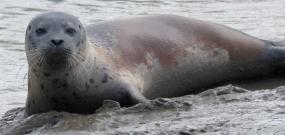
2 minute read
Turning back time & tide at Wallasea ..................................Chris Keeling
Chris Keeling Turning back time and tide at Wallasea
What do you do with 3 million tonnes of soil, mud and clay dug out from beneath the city of London by the Crossrail tunnelling project? The RSPB saw an opportunity to work with industry and develop a major coastal habitat creation project. The largest project of its kind in Europe, the project has involved bringing earth and clay by barge from the London Crossrail tunnel project to Wallasea Island in Essex, transferring it by conveyor belt in order to raise land levels, before breaching the island’s sea walls to create stepped levels of lagoons, saltings, islands and pastures crisscrossed by ditches that will be home to birds, water voles, reptiles and marine species.

Illustration: RSPB
Saltmarsh history –‘between a rock and a hard place’
Saltmarshes and associated coastal habitats survive as arguably the last unmanaged wild space in East Anglia. Subject to ‘coastal squeeze’ – caught between hard sea defences and the sea itself – they are forced out of sync with geological time, leading to increasing inundation and erosion. British saltmarshes are under threat: four hundred years ago there were 30,000 hectares of inter-tidal saltmarsh around the Essex coast. This now stands at just 2,500 hectares. lagoons of Wallasea Island fell back and reformed according to the whims of an indifferent nature, land and sea becoming merged in a truce understood by Redshank and Curlew, yet still coveted for the high quality grazing land that could be squeezed dry with sea walls and drainage. By the end of the 16th century the island’s marshes were replaced by a flat coastal plain lower than the highest tide, intersected by ditches and protected by walls of clay and turf. Only fishermen and wildfowlers valued the untamed transition zone beyond the seawalls that had to be rebuilt and strengthened after every storm. By the end of the 20th century, Wallasea was still economically viable agricultural land, but the seawalls had fallen into poor condition, while the value of the land itself failed to meet the Environment Agency’s criteria for continuing flood defence. Here was an opportunity to create wildlife habitat on a landscape scale, with the creation of 680 hectares of coastal habitats.
Common Seal
Adjacent conservation projects
Sited within the Crouch & Roach river estuaries, the project lies adjacent to the Wallasea Wetlands Creation Project, completed in 2006 and which was carried out to replace similar bird habitats lost to port development during the 1990s. Covering 115 hectares and originally Defra-led, this neighbouring project is now also managed by the RSPB. It is intended that the current project will build on the success of the neighbouring Defra scheme. Benefit for species
The presence of water voles, native reptiles and badgers – all legally protected species –










